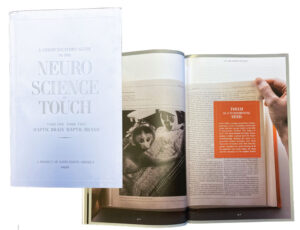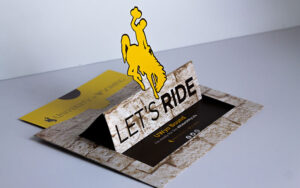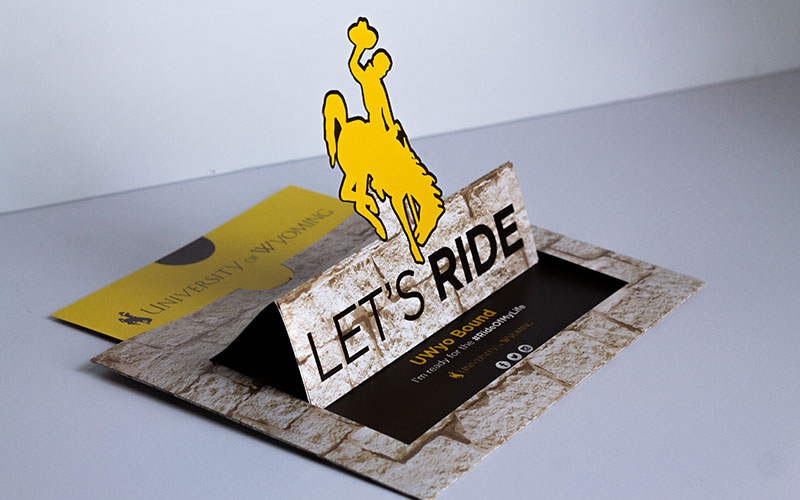Steven Schnoll, Schnoll Media Consulting
The following article was derived from the recent publishing of “Transforming Direct Mail with Print Embellishments,” a white paper commissioned by the Foil & Specialty Effects Association (FSEA).
Historically, one of the great attributes of printed pieces is the ability to engage the attention of those who receive them. Recently, that thought has been tested by the heavy use of digital marketing technologies. As marketers seek out alternative and less expensive digital media choices, direct mail has lost some of its popularity. However, a great deal of research has shown that a reader of a printed piece is more likely to recall that marketing piece than an online banner advertisement, including a 2015 study by the Canada Post that said “Direct mail requires 21% less cognitive effort to process than digital media… suggesting that it is both easier to understand and more memorable.” In addition, “When asked to cite the brand (company name) of an advertisement they had just seen, participants’ recall was 70% higher if they were exposed to a direct mail piece (75%) rather than a digital ad (44%).”1
Therefore, a top priority of marketers should be to maintain a close alignment with both new and traditional marketing methods to best communicate with end users. Successful graphic arts providers are working in concert with brand owners to facilitate successful delivery of content, offering direct mail as an essential part of that service portfolio. Print has always been recognized as a highly effective tool and, when embellishments are added to these printed pieces, a new experience is realized. Embellishments can boost the awareness factor for those engaged in building brand identity as these specialty effects draw attention, engage and motivate the recipient to trigger a positive action.
Joanne Gore, founder of marketing and communications company Joanne Gore Communications, was quoted in an article in WhatTheyThink magazine: “People spend 39% more time engaging in direct mail vs. digital campaigns alone, impacting brand experience, recall and results. Print has the power to keep readers informed and engaged. Adding textures and finishes like embossing, debossing, raised ink, foil or glitter teases them to do more than see print, but to touch it – and remember it.”2
This can be especially true for the younger generations. The myth is that Millennials and Gen Z’ers do not respect direct mail – or other printed material, for that matter – since smart devices and diverse digital technologies are stealing their attention. This has raised alarms among the print organizations and brand managers who must reach these potential buyers – now the largest generation in America – to grow business revenue. However, the research tells a different story.
In a study by the US Postal Service3, 84% of millennials take the time to look through their mail and 77% of them pay attention to direct mail advertising. In fact, 90% of millennials believe direct mail advertising is reliable and 57% have made purchases based on direct mail offers. To “create engaging mail pieces for this generation,” the US Postal Service study suggests that marketers “use enhancements such as scent, sound or texture to make your piece stand out.”
Embellishment techniques are a strategic way to gain momentum in the direct mail marketing world. The companies interviewed for this white paper cite meaningful results when leveraging embellishment offerings with printed mailing pieces.
Printed mail volume decreases, but response rates rise
According to USPS statistics4, marketing mail volume has decreased from 81.8 billion pieces in 2010 to 75.7 billion pieces in 2019 – a 7.45% dip in the last decade (first-class mail is down 43.89% over the same time period). However, recent numbers compiled by a 2018 DMA Response Rate Report shows that direct mail response rates are on the rise. Internal house lists received a 9% response rate, while prospect lists received an average response rate of 5%.5 Could some of that be due to creative embellishments that are catching the eye of these Gen X and Z generations?
Another interesting recent survey on “The 25 Most Trusted Brands in America” found that the United States Post Office ranked the highest No. 1 brand amongst Americans with a 42% rating.6 The fact that 42% of those surveyed believed they could rely “a lot” on the US Postal Service “to do what is right” is most revealing when evaluating the leverage direct mail has among consumers. MarketingSherpa reinforced that point with a survey that said 76% of consumers trust ads and catalogs they receive in the mail when making a purchase decision.7
With all the tools that marketers employ today, these statistics clearly illuminate the power of direct mail. But these direct mail pieces cannot be of a vintage nature. To make authentic connections with the target direct mail audience, brand managers need to utilize tactics that will resonate. Unless a direct mail piece strikes an immediate recognition factor with relevant personalization components and highly attractive designs that feature tactile coatings/laminates, embossing or decorative foil, the piece may lack an emotional bond. People react to messages that connect with them, and the story must be designed and highly personalized to enhance the message.
Mark Baugh, president of Baugh Graphic Finishing House, a print finishing and decorating operation in Indianapolis, Indiana, has seen an increase in volume in the direct mail market segment over the past several years. “The mailbox is a competitive marketplace – not much different than retail shelf space,” said Baugh. “Direct mail marketers have a very short time period to attract a potential customer, and embellishments have helped get the message across.”
Why does direct mail work?
Potential customers want to be treated as individuals, not as a commodity. Personalization – coupled with a relevant message – is one of the best ways to engage an individual. By using data to target the person to whom the direct mail piece is being directed (i.e. birthdate, wedding anniversary, new homeowner, etc.), the direct mail piece increases in value to that person. The direct mail piece becomes something more than a sales tool – it begins to build long-term business relationships that grow revenue.
Touch is an especially important element in a direct mail piece. When a potential customer opens the mailbox and starts to sort through the contents, a piece of mail that is enhanced with a special softness, look or shape becomes a powerful form of non-verbal communication. Couple that with intriguing imagery and a compelling personalized message, and a direct mail piece is a step ahead in capturing the attention of the recipient. This relates to the neuroscience of touch.

In 2015, Sappi North America produced a book called, “A Communicator’s Guide to the Neuroscience of Touch.” This book illuminated the science of haptics – or “how the things we touch shape the way we feel.” Feelings are an integral part of a purchase decision, so it makes sense to integrate ‘touch’ into printed direct mail as a means of gaining attraction. Dr. David Eagleman, director of Baylor College of Medicine’s Laboratory for Perception & Action, is the primary author of the publication. Dr. Eagleman explained, “In humans, touch represents a powerful form of non-verbal communication. Our sense of touch plays a fundamental role in daily life, from learning about objects to communicating with people.”
The book explained, “To touch a thing is to trigger a reaction: as soon as we do, we begin to feel differently about it. We begin to feel we own it, and research shows that makes us value it more.” This ‘endowment effect’ can translate into purchase decisions. “Scientific studies show that people who merely touch an object, or even imagine touching it, begin exhibiting a sense of ownership.”
If direct mail can trigger an ownership response, it follows that creating a touch-and-feel sensory experience through the use of specialty coatings and embellishments may enhance that response. Engaging the brains of consumers through touch increases interest in the messaging of a direct mail piece and increases the chances of achieving a brand’s marketing goals.
Embellishments drive results
It is a common misconception that many of the creative embellishments are too expensive to purchase and, therefore, make the process of offering these value-added services out of reach for many customers. Today, there are many ways Print Service Providers (PSPs) can work with printers and finishers to add specialty foils, coatings, and laminates to all types of printed materials. This includes hot and cold foils, digital foils and coatings, and specialty laminates (ex. soft touch). When these added embellishments encourage a higher direct mail response rate, the return on investment becomes evident.
MCD, Incorporated, a print finisher in Madison, Wisconsin, has seen an increase in recent years from customers looking to enhance direct mail pieces using foil stamping, embossing and specialty coatings. “We feel there is a direct correlation in increasing response rates by using specialty embellishments,” stated MCD National Sales Manager Sean Hurley. “By increasing brand recognition and perceived value, the customer’s response rate increases. We feel this justifies a slightly higher cost per piece and dramatically improves the customer’s return on investment.”
On the website home page of The Slate Group of Lubbock, Texas, is a phrase that transcends the success of the company: Educate and empower. The company has an array of offset and digital equipment, but it is not just the equipment that exemplifies its fantastic double-digit growth and profitability – the company also thinks “out of the box” with creative embellishment offerings. The Slate Group purchased a Duplo DDC-810 Spot Coater, and it has led them down the path of customers saying a lot of “oohs and ahhs” when they see the unique internal marketing pieces presented by the sales team. Don Denny, owner, believes, “a large part of our success is educating young designers who have never been in a printing plant to the many embellishment opportunities to make direct mail pieces stand out.”

“Customers are looking for ways to transcend the ordinary with their direct mail pieces,” according to Brad Phinny, COO for The Slate Group. A great example of a distinguished direct mail piece is one done by Slate for the University of Wyoming, which includes both diecutting and raised spot UV coating.
Denny added, “Our investment in embellishments has provided us with an excellent ROI and provided great value-add to retain customers.” With more than 1,000,000 direct mail pieces printed per month, embellishments have been a big “WOW” factor that leads The Slate Group to good partnerships and door openers.

D’Andrea Visual Communications of Cypress, California, calls itself a “visual solutions provider reimagined.” The company has embraced the world of embellishments with a diversified portfolio of offerings, including the addition of cold foil technology for its printing operation. The company added an Eagle Systems cold foil unit to offer metallic decorating as an added advantage for its customers. One of the best examples, as explained by account executive Denise Okata, is a piece done for FX Networks, a division of The Walt Disney Company. This piece is not a typical direct mail piece – instead, it is 64-page booklet.
The print run of 1,500 was directed to solicit local TV stations to air a television program. “This piece was expensive to produce but got an excellent return for FX,” said Okata. Hot and cold foil, debossing, flocking and special UV inks were employed to make this product truly unique and get the attention of the target recipients. “We are not a huge company,” she continued, “but we provide a boutique offering of services with creative ideas that separates us from our competitors.”
Conclusion
Direct mail is a significant part of every individual’s life, whether it is directed to a consumer or business – but not all direct mail is effective. As part of a 2019 study conducted on millennials9, one of the millennial consumer interviewees said, “I don’t read a newspaper… but I will look at a direct mail piece if it is highly personalized and has an intriguing design.”
Optimizing direct mail for consumers requires a seamless marketing platform that creates an engaging personalized message with attention-grabbing design techniques. Graphics organizations that take advantage of these concepts can propel their companies – and their customers – to higher levels of success.
When a printer goes beyond ink on paper to add the vibrant visual and tactile elements that can be experienced with diecutting, foil and other embellishments, a direct mail piece now resonates with statistical ROI for the customer.
Now is the time to reach out to print customers and prospects to encourage the use of embellishments to increase response rates and profitability with direct mail projects. Marketers are fighting for attention in the consumer’s mailbox. Embellishments are the key to winning the battle.
References
- “The neuroscience behind the response-driving power of direct mail,” July 31, 2015, https://www.canadapost.ca/assets/pdf/blogs/CPC_Neuroscience_EN_150717.pdf
- Gore, Joanna. “Marketing in a COVID-19 World.” WhatTheyThink, May 2020, pp. 24-27
- “Still Relevant: A Look at How Millennials Respond to Direct Mail,” accessed June 2020, http://www.lendingsciencedm.com/how-millennials-respond-direct-mail/
- A Decade of Facts and Figures, accessed June 2020, https://facts.usps.com/table-facts/
- “Is Direct Mail Dead?”, Mail Shark, accessed June 2020, www.themailshark.com/resources/articles/is-direct-mail-dead/
- The 25 Most Trusted Brands in America 2020, Morning Consult, accessed June 2020, https://morningconsult.com/most-trusted-brands/
- “Marketing Chart: Which advertising channels consumers trust most and least when making purchases,” MarketingSherpa, January 17, 2017, www.marketingsherpa.com/article/chart/channels-customers-trust-most-when-purchasing
- “Valassis Research Identifies Factors That Influence Consumer Shopping,” BusinessWire, February 17, 2020, https://www.martechcube.com/valassis-research-identifies-factors-that-influence-consumer/research
- 2019 Schnoll Media Consulting research project on how Millennials and GenZ view printed products





